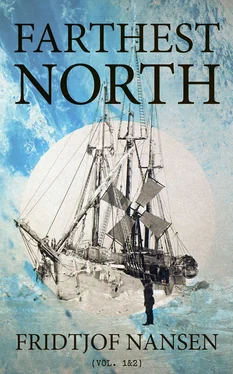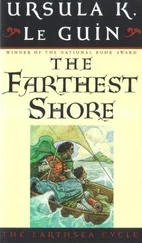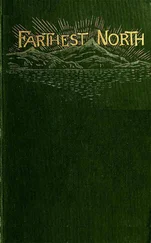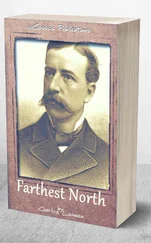The propellers, of which we had two in reserve, were two-bladed, and made of cast-iron; but we never used either the spare propellers or a spare rudder which we had with us.
Our quarters lay, as before mentioned, abaft under the half-deck, and were arranged so that the saloon, which formed our dining-room and drawing-room, was in the middle, surrounded on all sides by the sleeping-cabins. These consisted of four state-rooms with one berth apiece and two with four berths. The object of this arrangement was to protect the saloon from external cold; but, further, the ceiling, floors, and walls were covered with several thick coatings of non-conducting material, the surface layer, in touch with the heat of the cabin, consisting of air-tight linoleum, to prevent the warm, damp air from penetrating to the other side and depositing moisture, which would soon turn to ice. The sides of the ship were lined with tarred felt, then came a space with cork padding, next a deal panelling, then a thick layer of felt, next air-tight linoleum, and last of all an inner panelling. The ceiling of the saloon and cabins consisted of many different layers: air, felt, deal panelling, reindeer-hair stuffing, deal panelling, linoleum, air and deal panelling, which, with the 4-inch deck planks, gave a total thickness of about 15 inches. To form the floor of the saloon, cork padding, 6 or 7 inches thick, was laid on the deck planks, on this a thick wooden floor, and above all linoleum. The skylight which was most exposed to the cold was protected by three panes of glass, one within the other, and in various other ways. One of the greatest difficulties of life on board ship which former Arctic expeditions had had to contend with was that moisture collecting on the cold outside walls either froze at once or ran down in streams into the berths and on to the floor. Thus it was not unusual to find the mattresses converted into more or less solid masses of ice. We, however, by these arrangements, entirely avoided such an unpleasant state of things, and when the fire was lighted in the saloon there was not a trace of moisture on the walls, even in the sleeping-cabins. In front of the saloon lay the cook’s galley, on either side of which was a companion leading to the deck.
As a protection against the cold, each of these companion-ways was fitted with four small solid doors consisting of several layers of wood with felt between, all of which had to be passed through on going out. And the more completely to exclude the cold air the thresholds of the doors were made more than ordinarily high. On the half-deck over the cook’s galley, between the mainmast and the funnel, was a chart-room facing the bow, and a smaller work-room abaft.
In order to secure the safety of the ship in case of a leak, the hold was divided into three compartments by water-tight bulkheads. Besides the usual pumps, we had a powerful centrifugal pump driven by the engine, which could be connected with each of the three compartments. It may be mentioned as an improvement on former expeditions that the Fram was furnished with an electric light installation. The dynamo was to be driven by the engine while we were under steam; while the intention was to drive it partly by means of the wind, partly by hand power, during our sojourn in the ice. For this purpose we took a windmill with us, and also a “horse-mill” to be worked by ourselves. I had anticipated that this latter might have been useful in giving us exercise in the long polar night. We found, however, that there were plenty of other things to do, and we never used it; on the other hand, the windmill proved extremely serviceable. For illumination when we might not have enough power to produce electric light, we took with us about 16 tons of petroleum, which was also intended for cooking purposes and for warming the cabins. This petroleum, as well as 20 tons of common kerosene, 2intended to be used along with coal in the boiler, was stored in massive iron tanks, eight of which were in the hold, and one on deck. In all, the ship had eight boats, two of which were especially large, 29 feet long and 9 feet wide. These were intended for use in case the ship should, after all, be lost, the idea being that we should live in them while drifting in the ice. They were large enough to accommodate the whole ship’s company with provisions for many months. Then there were four smaller boats of the form sealers generally use. They were exceedingly strong and lightly built, two of oak and two of elm. The seventh boat was a small pram, and the eighth a launch with a petroleum engine, which, however, was not very serviceable, and caused us a great deal of trouble.
As I shall have frequent occasion later on to speak of other details of our equipment, I shall content myself here with mentioning a few of the most important.
Special attention was, of course, devoted to our commissariat with a view to obviating the danger of scurvy and other ailments. The principle on which I acted in the choice of provisions was to combine variety with wholesomeness. Every single article of food was chemically analyzed before being adopted, and great care was taken that it should be properly packed. Such articles, even, as bread, dried vegetables, etc., etc., were soldered down in tins as a protection against damp.
A good library was of great importance to an expedition like ours, and thanks to publishers and friends, both in our own and in other countries, we were very well supplied in this respect.
The instruments for taking scientific observations of course formed an important part of our equipment, and special care was bestowed upon them. In addition to the collection of instruments I had used on my Greenland expedition, a great many new ones were provided, and no pains were spared to get them as good and complete as possible. For meteorological observations, in addition to the ordinary thermometers, barometers, aneroids, psychrometers, hygrometers, anemometers, etc., etc., self-registering instruments were also taken. Of special importance were a self-registering aneroid barometer (barograph) and a pair of self-registering thermometers (thermographs). For astronomical observations we had a large theodolite and two smaller ones, intended for use on sledge expeditions, together with several sextants of different sizes. We had, moreover, four ship’s chronometers and several pocket-chronometers. For magnetic observations, for taking the declination, inclination, and intensity (both horizontal and total intensity) we had a complete set of instruments. Among others may be mentioned a spectroscope especially adapted for the northern lights, an electroscope for determining the amount of electricity in the air, photographic apparatuses, of which we had seven, large and small, and a photographometer for making charts. I considered a pendulum apparatus with its adjuncts to be of special importance to enable us to make pendulum experiments in the far north. To do this, however, land was necessary, and, as we did not find any, this instrument unfortunately did not come into use. For hydrographic observations we took a full equipment of water-samplers, deep-water thermometers, etc. To ascertain the saltness of the water, we had, in addition to the ordinary areometers, an electric apparatus specially constructed by Mr. Thornöe. Altogether, our scientific equipment was especially excellent, thanks in great measure to the obliging assistance rendered me by many men of science. I would take this opportunity of tendering my special thanks to Professor Mohn, who, besides seeing to the meteorological instruments, helped me in many other ways with his valuable advice; to Professor Geelmuyden, who undertook the supervision of the astronomical instruments; to Dr. Neumeyer, of Hamburg, who took charge of the magnetic equipment; and to Professor Otto Petterson, of Stockholm, and Mr. Thornöe, of Christiania, both of whom superintended the hydrographic department. Of no less importance were the physiologico-medicinal preparations, to which Professor Torup devoted particular care.
Читать дальше












